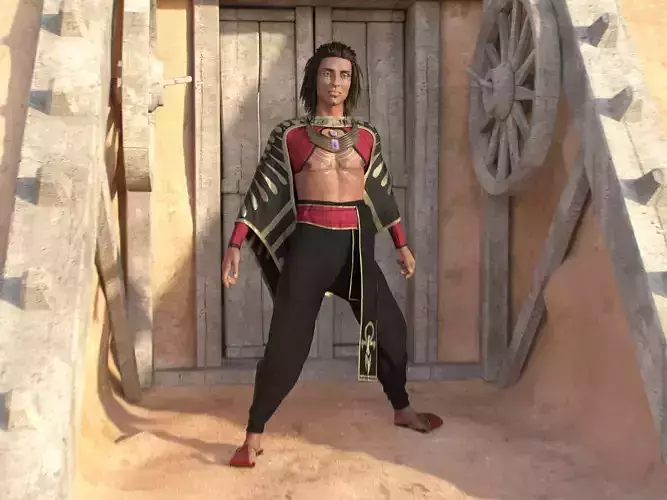1/26
Pharaohs Prince kings of ancient Egypt - Rigged
Photorealistic
Low-poly
PBR/Gameready
4K Texture Maps
POLYGONS - VERTICES
Body16384 vertices, 16196 polygons, 170 bones Brows 177468 vertices, 84876 polygons, 66 bonesCoth3149 vertices, 3005 polygons, 105 bonesCape2684 vertices, 2612 polygons, 60 bones Pant7983 vertices, 7908 polygons, 20 bones Shel3562 vertices, 3430 polygons, 11 bones Sui4854 vertices, 4800 polygons, 15 bonesTop 4856 vertices, 4742 polygons, 46 bones Lashes464 vertices, 352 polygons, 61 bonesHair 31376 vertices, 20443 polygons, 104 bonesLiner259762 vertices, 259136 polygons
In Ancient Egypt, the king was known as a pharaoh. The term pharaoh originally referred to the royal palace, but later came to be used for the living king, especially during the New Kingdom period. Pharaohs were believed to be divine rulers, intermediaries between the gods and the peopleAncient Egypt was a civilization that flourished for over 3,000 years, starting around 3150 BC and lasting until 30 BC. Located along the Nile River in northeastern Africa, it was a cradle of civilization and one of the most powerful and influential empires in the ancient world. The civilization was known for its pharaohs, impressive architecture like the pyramids, sophisticated writing system (hieroglyphs), and complex religious beliefs. Here's a more detailed look at Ancient Egypt:Geographic Context:Ancient Egypt was situated along the Nile River, which was crucial for its agriculture and civilization. The Nile's annual flooding provided fertile soil, making it possible to cultivate crops like wheat, barley, and papyrus. Political and Social Structure:Ancient Egypt was ruled by pharaohs, who were considered to be divine rulers. The civilization was divided into Upper and Lower Egypt, which were eventually unified under a single pharaoh. Society was structured with a hierarchical system, including priests, scribes, artisans, and farmers. Women in ancient Egypt had more rights and freedoms compared to other ancient cultures, including the right to own property and run businesses. Cultural and Religious Beliefs:The ancient Egyptians developed a complex system of beliefs, with many gods and goddesses. They believed in the afterlife and practiced mummification to preserve bodies for the afterlife. Hieroglyphs, a form of writing, were used for religious texts, official documents, and everyday communication. Architectural and Artistic Achievements:The pyramids of Giza are the most famous examples of ancient Egyptian architecture. The ancient Egyptians also built temples, palaces, and tombs, showcasing their advanced engineering and craftsmanship. Their art, including paintings and carvings, depicted scenes of daily life, religious rituals, and the afterlife. Legacy:Ancient Egypt's influence on art, architecture, and culture continues to be felt today.Archaeological sites and museums around the world preserve remnants of this ancient civilization, offering insights into its daily life, beliefs, and achievements
REVIEWS & COMMENTS
accuracy, and usability.


























